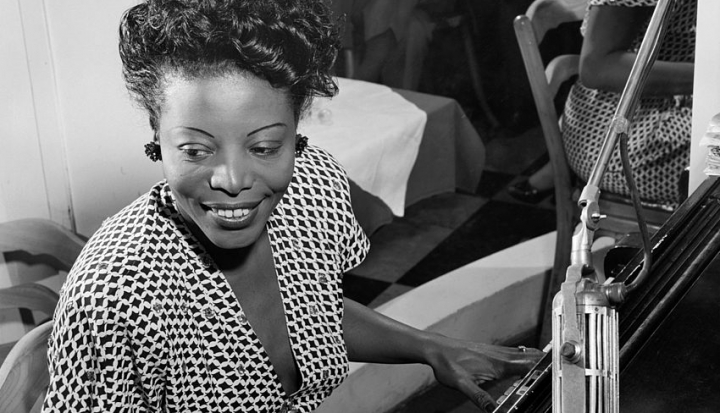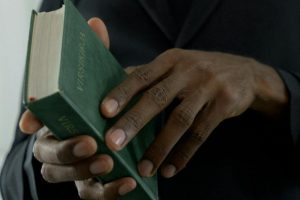The history of African American Catholicism began with the arrival of the Spanish settlers in the 16th century in Florida. In fact, on the first page of the 16th-century baptismal registers are the names of black infants who were baptized into the Body of Christ along with white infants in St. Augustine Church. Although the history of American Catholics is intertwined with the history of people of color, from the colonial period until today, African American Catholics have been too often the forgotten factor in the history of the American church (see accompanying timeline of Black Catholic history).
Today, when the history of American Catholicism is often misinterpreted and misconstrued, it is important to look again at the contributions of those found in the overlooked pages of American church history. To paraphrase the breviary hymn for the apostles: “They learned to reach beyond their grasp . . . they were glad to witness more than they saw, prepared to speak more than they knew.”
A witness to the Spirit
One evening in Paris in 1954, a renowned African American jazz pianist walked off the stage during a performance, cutting short her tour. Mary Lou Williams had reached a high point in her career as musician, composer, and jazz pianist before she returned to New York and went into seclusion. In a nearby Catholic church, she found a shelter, and she found God. In 1956, Mary Lou Williams entered the Catholic Church.
She had been born Mary Elfrieda Scruggs in Atlanta in 1910. Growing up in Pittsburgh, she was recognized as a child prodigy with remarkable musical gifts.
Encouraged by the priest who received her into the church, Williams began composing religious music in a jazz idiom: three Masses and a cantata in honor of Saint Martin de Porres. She began to work for the needy and to teach young students.
She was artist-in-residence at Duke University in North Carolina when she died in 1981. At the time of her death, she left a legacy of art and beauty. Even more, she left the example of how the artist’s performance can be channeled into prayer and how music might become the witness of the spiritual.
At some point, everyone must call a halt and evaluate the meaning of one’s life. The wisdom of Mary Lou Williams was to step back, to listen, and to evaluate. This is the turning point in one’s life journey. This is when all of us can look back and see God’s intervention in ourselves, in our community, and in our world.
Laying the foundation
About 40 miles southwest of Charleston, South Carolina stands a small church built in honor of Saint James the Greater. This church is a witness to the faith of black Catholics who persevered in their Catholic faith without priest or church for almost 40 years.
Before the Civil War, this small community known as Thomson’s Crossroad and later Catholic Crossroad was the site of several plantations. The plantation owners and many of their slaves had converted to Catholicism in the 1830s, and a church was erected and dedicated to Saint James the Greater by John England, the bishop of Charleston, in 1833.
The church was burned down in 1856, and the plantation owners moved away after the Civil War. But the black Catholics remained and so did their faith, thanks to the fidelity and zeal of a former slave, Vincent de Paul Davis, who owned a general store where he taught children their prayers and acted as godfather to the many infants who were carried to Catholic churches, often at a distance, where they were baptized. The old baptismal register now located at St. Anthony Church in Walterboro reveals several pages of names of people who were baptized with Vincent de Paul Davis as their sponsor.
Around 1892 the community of some 60 black Catholics was “discovered” by a Pallotine priest from Charleston, Father Daniel Berberich, who celebrated Mass with them twice a month. By 1894 a new church was built. Three years later a parochial school was added with a local teacher, and by 1901 there were two lay teachers. The present church was constructed in 1935.
Catholic Hill, its unofficial name, is a reminder to us all that a church is built of living stones. In this instance, they were those whose faith had been able to withstand time and neglect. The history of black Catholics is an ongoing saga of how black laypeople built our church and made firm its foundation even when others had forgotten them. Today St. James the Greater is still a mission and still a spiritual home for the local black community.
Catholics, both white and black, are accustomed to thinking of African American Catholics as recent converts. In fact, any ministry in the African American community will reveal many blacks whose Catholicism goes back to the dark days of slavery. Many have left the church because of neglect or outright hostility. Others felt that they were unwelcome and undernourished. Today, being black and Catholic means shining the beacon of hope in the darkness of discouragement, the searchlight of faith in the darkness of misunderstanding. Daniel Rudd, the black Catholic leader of the 19th century, described the black Catholic community’s task “to be a leaven for the race.”
God’s man of hope
There is no other way to describe Augustus Tolton than as a man of hope. He had learned to hope in the face of incredible odds. Born a slave in Missouri in 1854, the second of three children of Martha Chisley Tolton and Peter Paul Tolton, both slaves and both Catholics, he escaped from slavery with his mother, sister, and brother during the Civil War. His father had run away to join the Union Army in St. Louis, where he soon died.
Martha Tolton crossed the Mississippi River with her three children in a rowboat to Illinois where she joined many other blacks who had fled slavery to a free state. Growing up in poverty, Augustus soon developed a desire to become a priest.
With the support of two priests in Quincy, one of whom was a Franciscan, he looked for a seminary where he could study, but no American seminary was willing to accept an African American as a student.
Hoping against hope, with the help of the minister general of the Franciscans, Augustus Tolton found a place in Urban College in Rome, the seminary attached to the Congregation for the Propagation of the Faith, where students from Africa were already enrolled. When the time came for Tolton to be ordained, the cardinal prefect of the congregation announced that if the Americans had never seen a black priest it was time for them to see one.
After his ordination in 1886, Father Tolton was sent home to Quincy, Illinois, where he had a triumphal return. Later, however, he suffered petty persecution by a fellow priest in a nearby parish. In 1889 Tolton moved to Chicago, and with the support of the archbishop, began a black parish with the name of St. Monica.
That same year Saint Katharine Drexel began the Sisters of the Blessed Sacrament, whose vocation was to evangelize blacks and Native Americans. Drexel used the enormous fortune left to her by her father for her work. In 1890 Tolton wrote to Drexel asking for financial help in the construction of his parish in Chicago.
His letters reveal the great simplicity of this very holy man and the sense that he had of the burden God had given him in the service of African Americans.
In an 1891 letter to Drexel, he wrote:
I for one cannot tell how to conduct myself when I see one person at last showing their love for the colored race. One thing I do know and that is it took the Catholic Church 100 years here in America to show up such a person as yourself . . . . In the whole history of the church in America we can’t find one person that has sworn to lay out their treasury for the sole benefit of the colored and Indians. As I stand alone as the first Negro priest of America, so you Mother Catherine stand alone as the first one to make such a sacrifice for the cause of a downtrodden race. Hence the South is looking on with an angry eye, the North in many places is criticizing every act. Just as it is watching every move I make. I suppose that is the reason why we had no Negro priest before this day, they watch us just the same as the Pharisees did our Lord.
He went on to express his great hope for the future:I really feel that there will be a stir all over the United States when I begin my church. I shall work and pull at it as long as God gives me life, for I see that I have principalities to resist anywhere and everywhere I go.
Tolton did not know that the Healy brothers, former slaves from Georgia, were the first black priests in America. Still Tolton, whom everyone knew to be black, did leave a model of holiness and service that would inspire the many African American priests who would follow him. Tolton died suddenly in 1897. His life was a witness to one man’s untiring hope; we are a witness to his undying faith.
The story of the first black priests in the United States is in many instances a tragic one. Still, it is also a story of courage and perseverance. In fact, this alternating experience of tragedy and courage, discouragement and achievement is the story of everyone who takes up the cross daily to follow Christ. Evangelization in our church today for African Americans means recalling the story of the black saints in our country who blazed a trail before us.
Lena Edwards
In 1964, a small African American woman named Lena Edwards, already a living legend, was awarded the Presidential Medal of Freedom by President Lyndon B. Johnson. She was an indefatigable worker in the cause of health and healing, especially for the poor and the forgotten.
Born in 1900 into a black, Catholic, middle-class family in Washington, D.C., she was still in high school when she developed a desire to become a physician. She attended Howard University in Washington, D.C., a traditionally black university, where her father was a professor in the dental school. In 1924 she graduated from the medical school at Howard and began her medical practice in Jersey City, N.J. with her husband, also a physician.
Dr. Lena Edwards became a specialist in obstetrics and gynecology, serving on the staff of the Margaret Hague Maternity Hospital for almost 30 years before accepting a teaching position back in Washington, D.C. at the Howard University Medical School.
Edwards was as fervent a Catholic as she was a physician. She raised six children, one of whom is an Atonement Friar, almost single-handedly. A Franciscan tertiary, she attended Mass daily and personally lived a life of voluntary poverty. Besides her participation in civic affairs, she worked for interracial justice as a member of the Catholic Interracial Council. She served just as faithfully in community affairs related to the welfare of the poor and to minorities. In her teaching she stressed the need for physicians to be as concerned about the social conditions of their patients as with their medical needs.
At 60, Edwards gave up her teaching and went to Texas to practice medicine among migrant workers. Using her own funds and money from other sources, she began a maternity hospital, trained a staff, and started a credit union.
Eventually forced to give up her work among the migrant laborers because of ill health, she returned to New Jersey where she continued her community work, her talks and conferences, as well as her financial support of many college students, including the establishment of a scholarship for women medical students at Howard University.
Edwards died in 1986 at the age of 86, leaving the memory of a courageous lay woman who lived out her mission to “exercise [Christ’s] apostolate in the world as a kind of leaven,” as stated in the Vatican II document on the laity.
Llewellyn Scott
In December of 1978, one of Washington’s true men of God died. Llewellyn Scott was born in Washington, D.C. in 1892. As a boy he had been stricken with rickets, a bone disease caused by a deficiency in Vitamin D. It crippled him so badly that he could not walk.
Thanks to the interest of the wife of the Army surgeon general, the young boy was given medical treatment. Scott was finally able to walk for the first time at the age of 10. He was enrolled in a parochial school, became a Catholic, and was finally able to catch up on his schooling.
In time, he graduated from Howard University and served in the Army in World War I. He briefly taught school in North Carolina and in the District of Columbia, and then became a social worker.
Everything changed, however, at the beginning of the Great Depression in 1930. He acquired property in the heart of Washington and opened the Blessed Martin de Porres Hospice to provide shelter and food for homeless men, funded at first with a donation from Dorothy Day and his own life savings. The hospice was open to all but especially to black men who often were unable to find assistance elsewhere. Scott finally gave up his government job and devoted all of his time and effort to the service of homeless men.
Scott was a short, unprepossessing man, soft-spoken and nonthreatening. He was someone in whom men could confide and to whom one could talk. His hospice was openly Catholic and always had a chapel and a space for prayer. Scott, who like Edwards had great devotion to Saint Francis, was received by three popes and received annual donations from the archbishop of Washington, and in his own quiet way was active in the civil rights movement. He marched with the Rev. Martin Luther King Jr. shortly before King’s murder in Memphis.
Scott died from leukemia in 1978 at the age of 86. For some he was simply an ordinary man; but for all he was a man who did extraordinary things. He touched the lives of many across the country, and he turned the lives of some completely around. All this was done without an imposing staff, without programs, without forms and paperwork, without fanfare-he simply walked with Christ on the streets of Washington.
More than 30 years ago on his visit to the shrine of the Ugandan martyrs, Pope Paul VI launched a challenge to the people of Africa to bring to the Catholic Church their precious and original gift of “blackness.” The challenge has reached all the sons and daughters of Africa, even today.
Our spiritual gifts have been the lives and works of countless people who have walked, and walk still, in the sight of God. Despite the violence of chains, ropes, and whips; despite the pettiness and the rejection, they have built up the church and made her holy.
This article appeared in the August 2002 issue of U.S. Catholic (Vol. 67, No. 8; pages 28-33).
Image: via Wikimedia Commons













Add comment